- Author Matthew Elmers [email protected].
- Public 2023-12-16 21:49.
- Last modified 2025-01-24 09:17.
The Japanese army first encountered Soviet-made tanks and armored vehicles in the late 1930s during hostilities in China and during military conflicts in the area of Lake Khasan and the Khalkhin Gol River. Soviet, Chinese and Mongolian troops used light tanks T-26, BT-5, BT-7 and armored vehicles BA-10 with bulletproof armor, which were vulnerable to 37 mm anti-tank guns and 20-mm anti-tank guns.
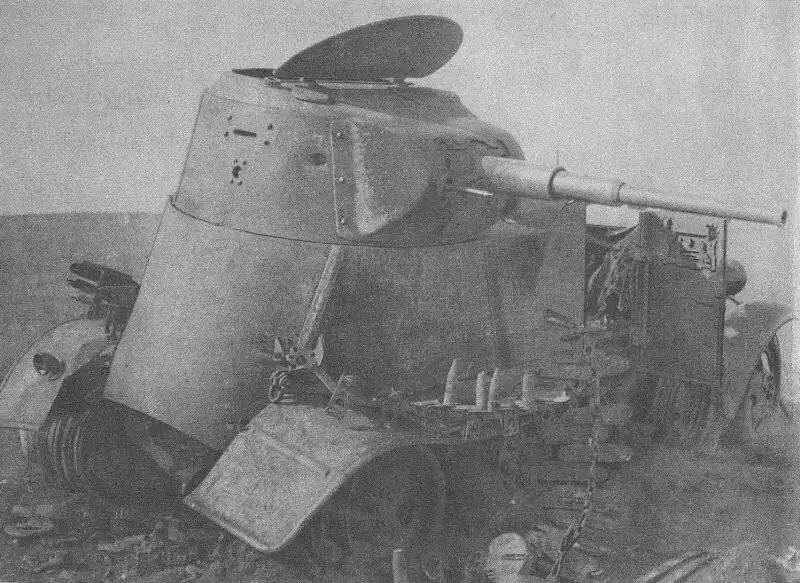
Anti-tank rifle Type 97
During the fighting on Khalkhin Gol, the Japanese infantry first used the Type 97 20 mm anti-tank gun. It entered service in 1937 and was used by Japanese troops until the end of World War II. The Type 97 PTR was heavy and not very convenient to handle, but it significantly increased the capabilities of the Japanese infantry in the fight against enemy armored vehicles.
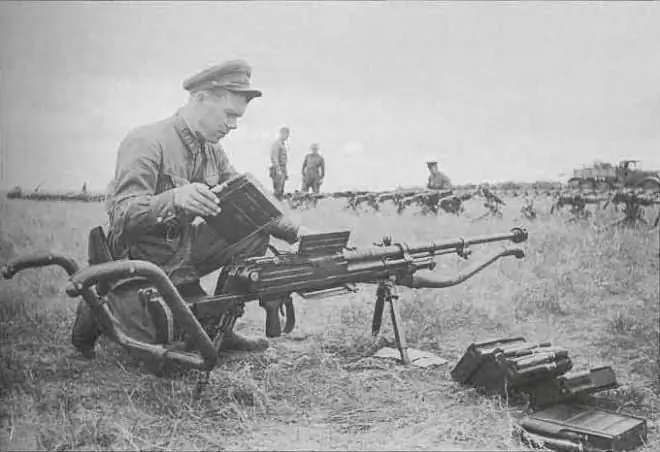
For firing from the Type 97 PTR, 20x124 mm ammunition was used, originally developed for use in 20-mm anti-aircraft guns. The ammunition load could include: armor-piercing tracer, high-explosive tracer, high-explosive incendiary and incendiary tracer shells. For firing at armored vehicles, an armor-piercing tracer projectile weighing 109 g was used, which left a barrel 1064 mm long at a speed of 865 m / s. At a distance of 250 m, it could normally penetrate 30 mm armor, which was a very good indicator in the second half of the 1930s.
The automatics of the 20-mm anti-tank rifle worked by diverting part of the powder gases. In order to increase the reliability of the weapon's functioning in different conditions and for the use of different types of ammunition, the gas outlet pipe of the anti-tank rifle was equipped with a regulator that made it possible to change the gas pressure on the piston. Food was supplied from a detachable 7-round magazine. Combat rate of fire reached 12 rds / min. Sights made it possible to fire at a distance of up to 1000 m.
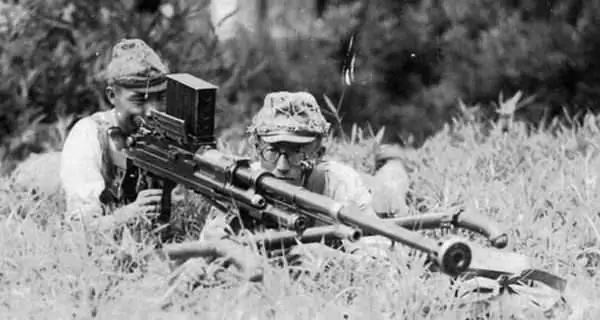
Although the armor penetration and rate of fire of the Type 97 anti-tank rifle were at their best at the time of creation, the anti-tank gun had a lot of shortcomings. Automatics when firing gave up to 5% delays. The most common reason was not ejection of the spent cartridge case. But if the calculations put up with this, then the transportation of the PTR on the battlefield caused many problems. Before carrying the gun, the crew had to install special metal handles. The designers believed that the anti-tank gun would be carried by two crew numbers, but in practice, the transportation of weapons required the involvement of more people. Typically, the Type 97 PTR was carried by three or four fighters. The mass of the weapon, without handles and a shield, was 52.2 kg. An unloaded gun with a shield and handles weighed 68 kg. Due to the large weight of the Type 97 PTR, it was used mainly in defense. To reduce the very strong recoil, there was a muzzle brake on the gun, but when fired, the powder gases scattered in the horizontal plane raised dust, which made observation and aiming difficult, and also unmasked the firing position.
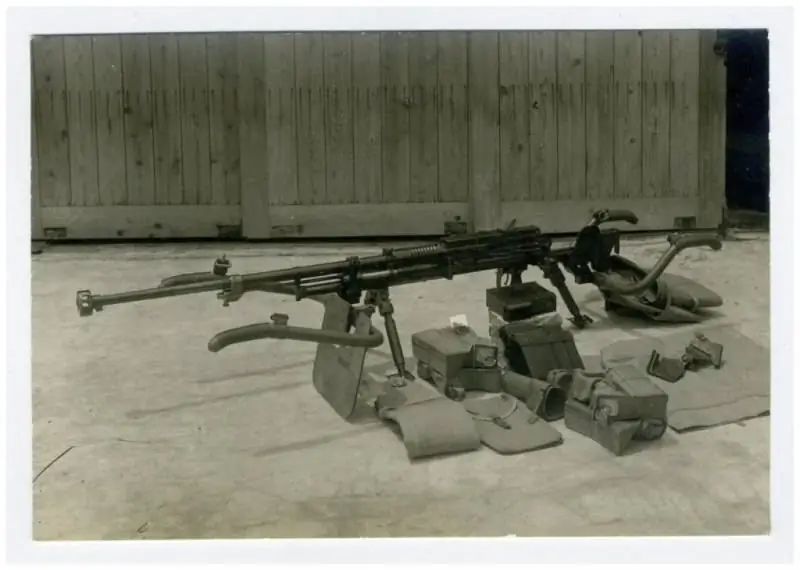
But perhaps the main drawback of the Type 97 anti-tank rifle was its very high cost. In 1941, the price of one 20-mm PTR, manufactured in the Kokura arsenal, was 6400 yen. By comparison, the Type 38 6.5mm rifle cost just 77 yen. Due to the high cost, after the release of approximately 1,100 copies, the production of the Type 97 PTR was curtailed in the second half of 1941. However, in 1943, Nihon Seikosho received an order for the manufacture of new guns. The loading of the enterprise did not allow him to release a large number of anti-tank weapons, and a little more than 100 anti-tank rifles were handed over to the military.
Despite the relatively small circulation, the Type 97 PTR was used in hostilities until the surrender of Japan in August 1945. The 20 mm rounds pierced the relatively thin side armor of the M3 / M5 Stuart light tanks, and also successfully hit the LVT amphibious transporters from any direction. When repelling the landing of assault forces on the Pacific islands, the Type 97 PTR created many problems for the American marines. At the same time, the excessive weight of the 20-mm gun forced fire from stationary positions, which were quickly identified and suppressed. In addition, even in the event of armor penetration, the damaging effect of the 20mm shells was relatively small.
Although the Red Army used armored vehicles in fairly large volumes on Khalkhin Gol, the command of the Imperial Japanese Armed Forces did not draw appropriate conclusions and did not bother equipping infantry units with a sufficient number of effective anti-tank weapons. This was partly due to the fact that the land army in Japan was financed on a leftover basis, it did not participate in the battles of the First World War and until the second half of the 1930s did not face a strong enemy. 20-mm anti-tank guns after the appearance of tanks with anti-cannon armor no longer met modern requirements, and the problem of anti-tank defense of the infantry had to be urgently solved by using various improvised and surrogate means.
Anti-tank grenades, bundles and Molotov cocktails
The simplest means of dealing with enemy armored vehicles, which could be quickly manufactured in the field, is a bunch of hand grenades. For this, the Type 98 grenade was best suited, which was an adapted copy of the German M-24 "mallet". It externally differed from the German prototype by a shortened handle.

The body of the grenade is made of cast iron and had a thread at the bottom for attaching a wooden handle. The picric acid charge was placed inside the case and packed in a paper cap. With a grenade mass of 560 g, it was loaded with 50 g of explosive. The deceleration time for the fuse is 6-7 s. In order to destroy the track or damage the chassis of the tank, it was necessary to attach 5-6 grenade bodies to a grenade with a fuse, and the weight of the bundle was 2.5-3 kg. It is clear that it was relatively safe to use such a design only from a trench. To increase the high-explosive effect, the body of the Type 98 grenade was often tied with melenite checkers.
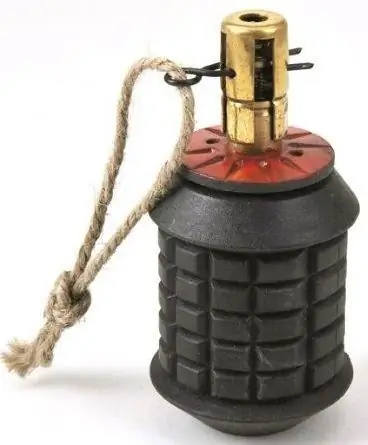
Also, the Japanese armed forces used several types of grenades without handles with cast bodies that had vertical and horizontal notches. Such grenades could be attached with wire or rope to a wooden stick. The Touré 97 grenade weighed 450 g and contained 65 g of TNT. The deceleration time of the fuse is 4-5 s.
A common feature of all Japanese fragmentation grenades was the inconvenience of their use and low effectiveness in anti-tank warfare. Due to the imperfection of the fuses, their response time varied greatly, which could be dangerous for those who used them. In 1943, the Type 3 anti-tank grenade was adopted by the imperial army, which the American Marines called the "Fox Tail" for its peculiar appearance.
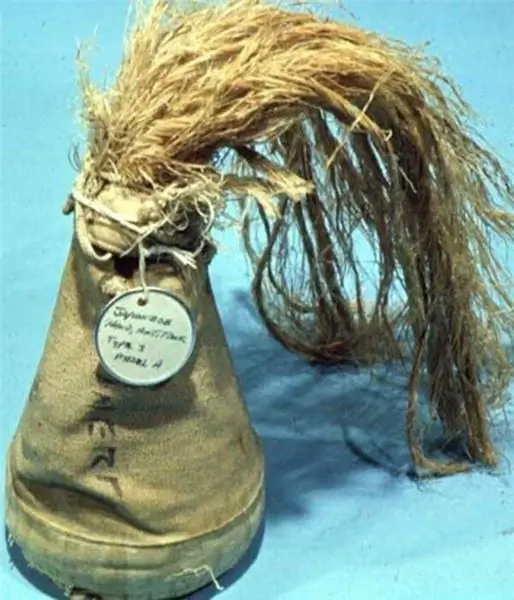
The construction of the Type 3 grenade was very simple, and available and cheap materials were used in its production. The explosive charge was placed in a cloth case. In the upper part of the charge, a metal ring with a thread was attached with a clamp, into which the fuse was screwed. The same clamp fixes the cloth cover. A stabilizer made of hemp or silk twine was attached to the grenade with a clamp. From below, the charge rests on a wooden base. At the head of the grenade there was a cumulative funnel, lined with steel or aluminum with a thickness of 3 mm. Before the throw, the cloth tape was removed from the grenade and the safety check was removed. Thanks to the stabilizer, the Type 3 grenade flew forward with its head. An inertial fuse was triggered when it hit an obstacle.
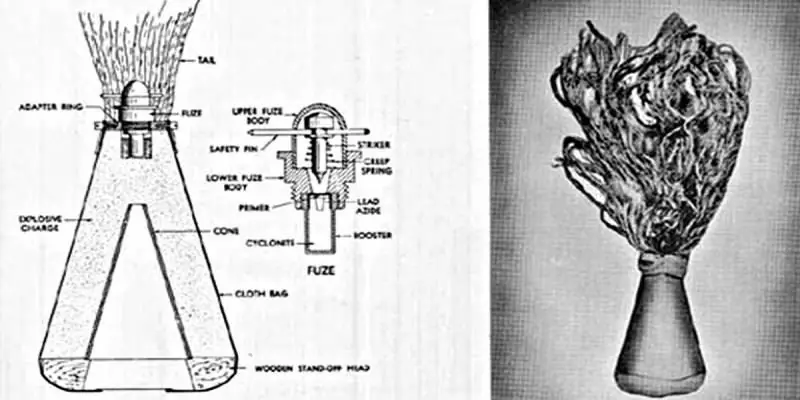
Several modifications of the Type 3 grenade are known: Ko (Type A), Otsu (Type B) and Hei (Type C). They differed in size, weight and filling. Modification Type A (bag color - white or brown-yellow) weighed 1270 g and was equipped with 853 g of a mixture of RDX and trinitroaniline. The Type B variant (the color of the bag was white or brown-yellow) had a mass of 855 g and contained a mixture of TNT with PETN. The last, most compact and lightest modification (the color of the bag is yellow) with a weight of 830 g contained 690 g of picric acid.
The English-language reference books say that all modifications, when hit at a right angle, had the same armor penetration - 70 mm. That, however, given the use of various metals for lining the cumulative funnel and explosive components that differed in detonation speed and power, is extremely unlikely. Now it is impossible to reliably establish how thick the armor of this or that modification of the Type 3 anti-tank grenade could penetrate. But the specified armor penetration theoretically made it possible to hit the frontal armor of the M4 Sherman tank. A well-trained and physically developed soldier could throw a Type 3 Hei anti-tank grenade at 25 m, but usually the aimed throw did not exceed 15 m. This anti-tank grenade contained a minimum of metal parts and gave the grenade launcher more chances to survive than a bunch of frag grenades.
Quite predictably, the Japanese military tried to fight tanks with glass bottles filled with fuel. At the first stage, these were bottles filled in the troops with a mixture of low-octane gasoline with used engine oil. Before throwing such an incendiary projectile at an enemy tank, it was necessary to light a tow plug wick.
Since 1943, the industrial production of glass incendiary grenades, filled with a flammable liquid with rubber dissolved in it, was organized. The rubber acting as a thickener, which did not allow the incendiary mixture to drain, quickly contributed to the fact that the ignited liquid adhered to the armor of the tank and an opaque film formed when it hit the observation devices. The burning of the rubber-thickened fire mixture was accompanied by thick black smoke, which greatly limited the visibility for the tank crews. A commercially made bottle of incendiary liquid was sealed with a sealed stopper. When broken against the armor, the fuel was ignited by a special chemical composition in fabric bags, which was attached to the bottle with tapes. Incendiary bottles were supplied to the troops in cardboard or tin cases, which protected them from mechanical stress.

Simultaneously with the incendiary, the Japanese army actively used smoke glass grenades filled with titanium tetrachloride. After the glass wall of the pomegranate collapsed, a chemical reaction took place, in which titanium tetrachloride, evaporating, reacted with water vapor contained in the air. In this case, the chemical compound decomposed into titanium dioxide and hydrogen chloride, with the formation of thick smoke. The smoke cloud dazzled the tankers and allowed the Japanese infantry to approach the tanks. Smoke glass grenades were used especially actively in Okinawa. Often seeing clouds of thick white smoke ahead, American tank crews preferred to retreat and called for artillery fire or air support.
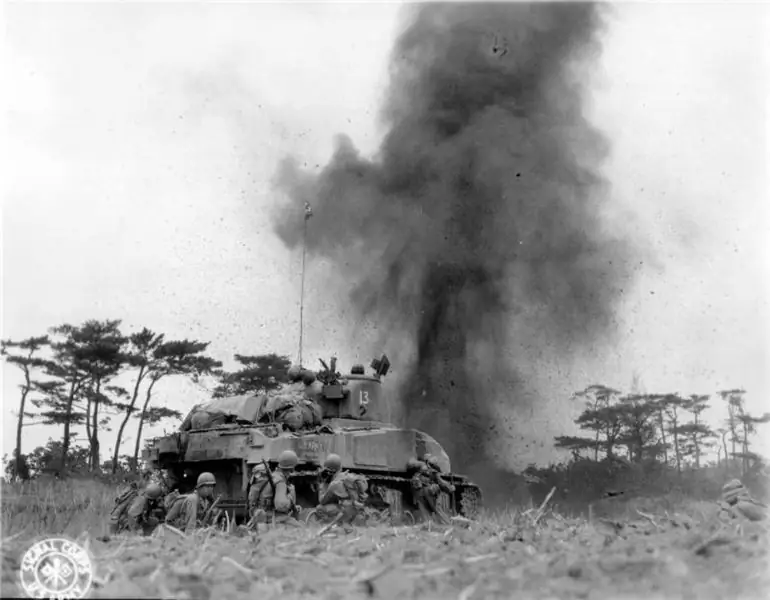
Anti-tank mines
In addition to grenades and bottles, the Japanese infantry could use several types of mines to combat tanks. The Type 99 magnetic mine, which was put into service in 1939, was intended for direct installation on the armor. Like most Japanese anti-tank mines, its design was extremely simple and cheap.
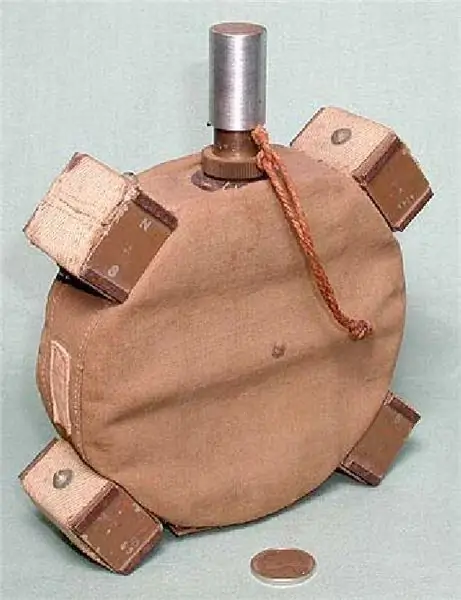
The body of the mine was a canvas bag, in which there were eight pieces to sweep melinite with TNT. Above there was a delayed action fuse, designed for 7-10 seconds. The mine is attached to the side of the tank using four magnets located on the side of the canvas bag. Before attaching the mine to the tank, it was necessary to pull out the safety pin by the lace, and hit the fuse head on a solid object. Weighing a magnetic mine of 1, 23 kg, it contained 680 g of explosives. Mine diameter - 121 mm, height - 40 mm. The magnetic mine had only a high-explosive effect, and could penetrate 20 mm thick armor. To increase armor penetration, several mines could be fastened together. Two magnetic mines could penetrate 38 mm of homogeneous armor, three - 46 mm. The mines were delivered in canvas bags, where the fuse was also kept.
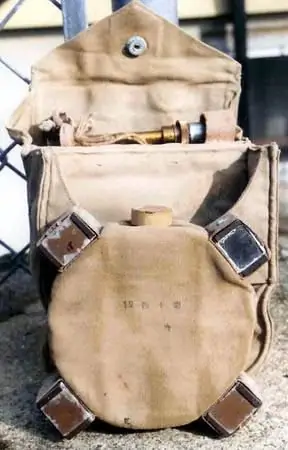
The implication was that Japanese soldiers should attach magnetic mines to the bottom of tanks passing over their trenches, or, running up to a moving tank, place mines on the side or stern. In this case, the fuse should have been initiated in advance. It is clear that with this method of application, the probability of surviving the one who installed it was small. However, the Type 99 mines were used until the end of hostilities.
A pole mine with rubber suction cups was intended for attachment to the side or stern of the tank. The tin case of the mine contained up to 2 kg of TNT-RDX alloy. This amount of explosives was enough to break through 30 mm armor. Even if a through-hole did not occur, pieces of metal broke off from the inner surface of the armor, striking the crew.
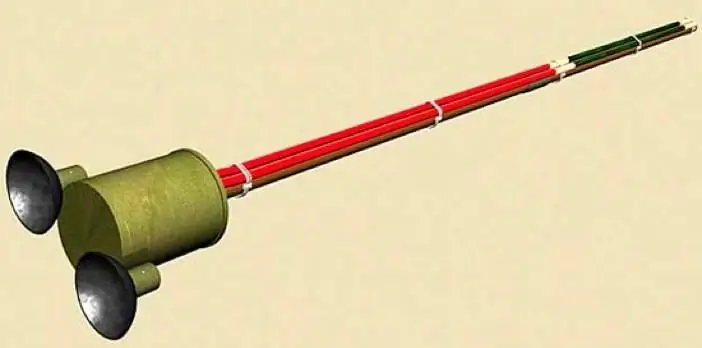
The fighter, fixing the mine on the suction cups, activated the grater igniter, which set fire to the fuse, which burned for 12-15 seconds. During this time, a soldier of the imperial army had to leave the affected area or take refuge in a trench.
Approximately at the same time as the anti-side high-explosive mine, which was attached to the tank's armor with rubber suction cups, the Ni04 high-explosive pole mine entered service, which could be placed under the tank's track.
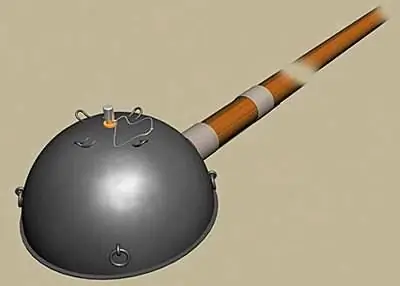
This anti-tank ammunition had a hemispherical metal body filled with 3 kg of TNT or melinite. In the upper part of the hemisphere there was a push fuse, which was activated when the tank hit a mine. Taking into account that the length of the bamboo pole was no more than 2 m, a close explosion of a 3 kg charge of powerful explosives in an open area was guaranteed to kill the one who used a mine against the tank. If a Japanese soldier managed to hide before an explosion in a trench, then at best he received a severe concussion.
Also at the disposal of the Japanese infantry were Type 93 universal mines, which, depending on the fuse, could be used as anti-tank and anti-personnel mines. The push action fuse was supplied in two versions - for an actuation force of either 31-32 kg, or 110-120 kg. The body of the mine, made of tin, contained 907 g of melinite, the mine itself in the equipped state weighed 1.36 kg. Case diameter - 171 mm, height - 45 mm.
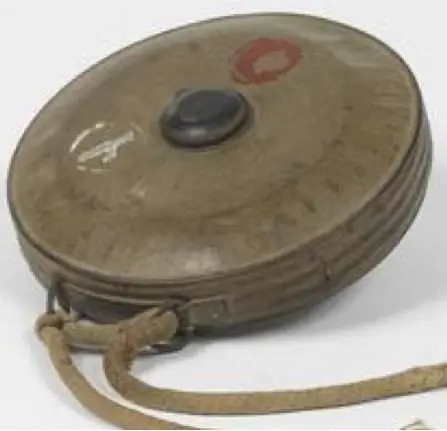
Unlike other engineering ammunition, which served for setting anti-tank minefields, the Type 93 mine was intended from the very beginning for use by the infantry. Due to the relatively small mass and dimensions, it was quite easy to move with it on the battlefield and quickly place it in the path of moving tanks. Also on the hull there were rings for ropes, with the help of which the mine could be dragged under the track of the tank. However, with excessive power for use as an anti-personnel mine, an explosive charge that was insufficient for an anti-tank mine did not allow serious damage to the tank. In most cases, when a Type 93 mine exploded on Sherman medium tanks, the case ended in a broken track.
In addition to the Type 93 metal hull mine, the Japanese infantry also had Ni 01 and Type 3 wood hull anti-vehicle mines. Among the most commonly used were the elongated anti-vehicle mine, designated in the United States as the Yardstick.
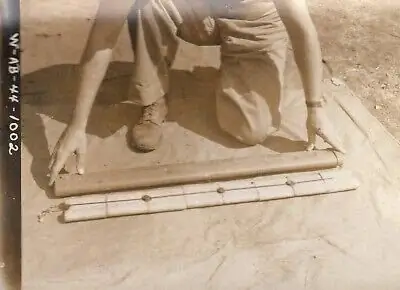
The anti-vehicle mine had an oval-shaped metal body 94 cm long. The total weight was 4.76 kg, of which 1840 g was an explosive (melinite). The mine had four push action fuses with an actuation force of about 120 kg. Due to the longer length, the likelihood that the tank would run over an elongated mine was higher.
After it became clear that the balance in the Pacific theater of operations was leaning towards the allies, the Japanese armed forces widely used kamikaze tactics not only in air and sea battles, but also on land. Initially, Japanese suicide soldiers blew up British and American armored vehicles, hung with grenades and explosive bombs, or threw themselves under a tank with an anti-tank mine in their hands. Later, special backpacks with surrogate explosives based on ammonium nitrate and cumulative pole mines of instant action Ni05 were used.
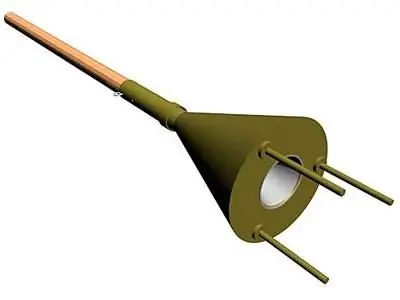
In American sources, this anti-tank ammunition is referred to as the Lunge Mine. By its design and method of application, Ni05 belongs to anti-aircraft cumulative mines. Structurally, the mine is very simple. A TNT charge weighing about 3.5 kg was placed in a cone-shaped case made of tin. In the lower part of the body there is a cumulative recess, lined with iron. Three metal legs are welded to the lower plane of the body, designed to ensure that at the moment of explosion the charge is at a strictly defined distance from the armor, which ensures optimal formation of a cumulative jet. The upper part of the body is a short cylindrical tube with an external thread. A long tube is screwed onto this tube, the end of which is broadened and has an internal thread. A bamboo pole up to 2 m long is inserted into a long tube. The total mass of the mine is about 6.5 kg. The diameter of the case at the bottom is 20.3 cm, the length of the case is 48 cm. Armor penetration is more than 150 mm.
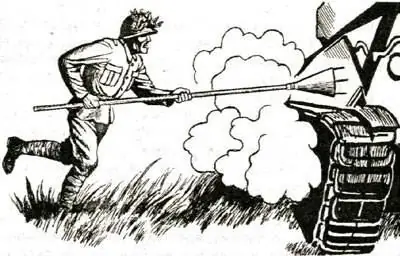
Before using the mine, the soldier had to remove the safety pin. Then he ran to the tank, holding the mine horizontally in front of him like a pike, aiming at the side of the tank. At the moment the mine hit the side with its legs, the pole, moving forward by inertia, broke the shear pin. The striker acted on the detonator cap, which led to its explosion and transferred the detonation to the shaped charge. The explosion of the shaped charge led to the penetration of armor and the destruction of the tank. Kamikaze also died in a mine explosion.
Anti-tank grenade launchers
Although since the second half of 1943, the Japanese command in the fight against tanks relied on primitive anti-tank ammunition used by ground kamikaze, it should not be assumed that Japan did not create "remote" anti-tank weapons, in which the risk of damage to personnel by shrapnel and shock was minimized. wave and there was no need to leave the shelter. Within the framework of military-technical cooperation with Germany in 1941, documentation was received for the Panzergranate 30 (G. Pzgr. 30) anti-tank 30-mm cumulative grenades. Japanese designers adapted Panzergranate 30 to their production capabilities and created the Type 2 rifle grenade launcher.
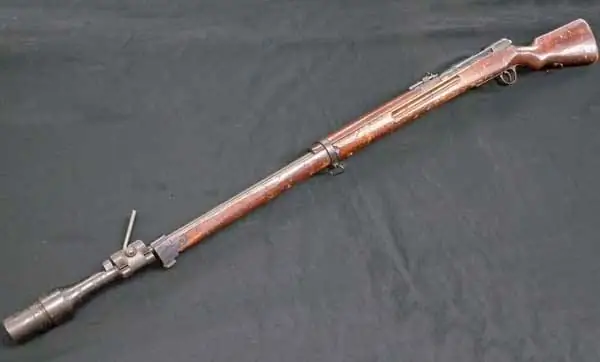
The Type 2 grenade launcher was installed on Japanese 6, 5 mm Type 38 and 7, 7 mm Type 99 rifles. wooden bullet. This slightly increased the range of the shot, but it was necessary to strengthen the bottom of the grenade. The maximum range of a shot from a Type 99 rifle at an elevation angle of 45 ° is about 300 m. Aiming range is no more than 45 m. The firing range of grenades with 6, 5-mm rifles was about 30% less.
To stabilize the grenade in flight, in its tail section there was a belt with ready-made grooves, which coincided with the rifled part of the mortar. The head of the grenade was made of tin, and the tail was made of aluminum alloy. In the head part there was a cumulative funnel and a charge made of an alloy of TNT with RDX weighing 50 g, and in the back - a bottom fuse. A cumulative 30-mm grenade weighing about 230 g along the normal could penetrate 30 mm armor, which made it possible to fight only with light tanks and armored vehicles. Due to insufficient armor penetration, a 40-mm cumulative grenade with an over-caliber warhead soon entered service. The mass of the grenade increased to 370 g, while its body contained 105 g of explosives. The thickness of the penetrated armor when hit at an angle of 90 ° was 50 mm, and the maximum range of a shot from a rifle grenade launcher was 130 m.
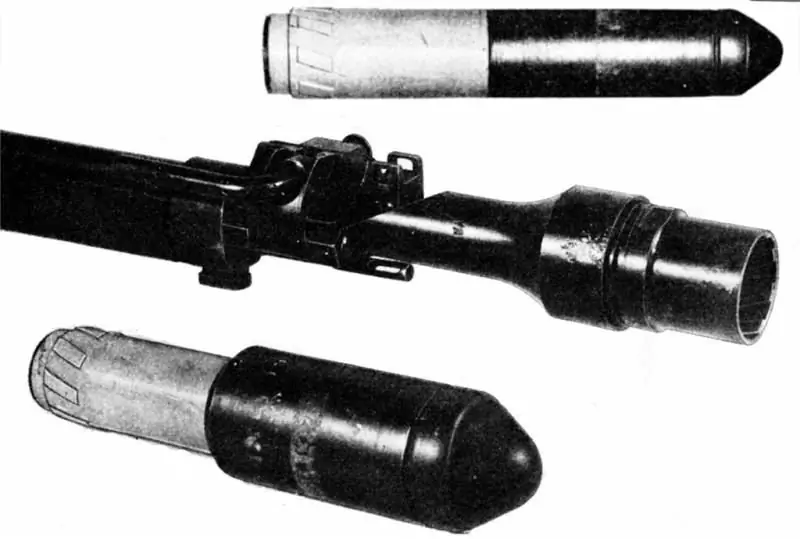
In theory, infantrymen armed with Type 2 grenade launchers with 40mm grenades could hit American M3 / M5 Stuart light tanks from any direction, and medium M4 Sherman into the side. However, the accuracy and firing range of cumulative rifle grenades was low, and the reliability of the timely operation of the bottom inertial fuse left much to be desired.
After the captured American "bazookas" fell into the hands of Japanese designers, work began in Japan to create its own rocket-propelled anti-tank grenade launchers. In July 1944, a 74-mm grenade launcher, designated Type 4, was adopted.
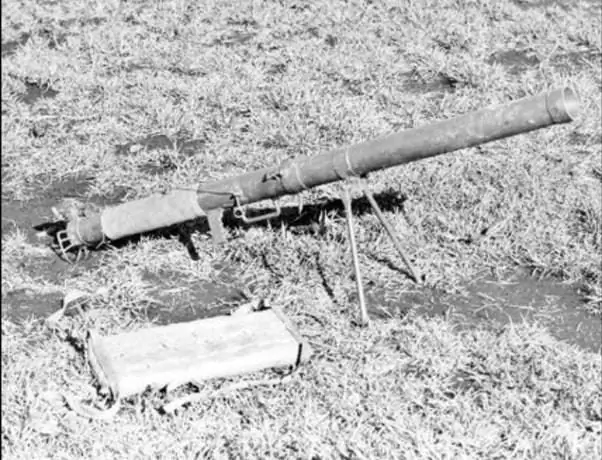
Apparently, the design of the Type 4 RPG was influenced not only by the American Bazooka, but also by the German Panzerschreck. By analogy with the American M9 Bazooka grenade launcher, the Japanese Type 4 RPG, created by the designers of the army arsenal in the city of Osaka, was collapsible and consisted of two parts, which were assembled only before the battle, and on the march the grenade launcher was transported disassembled. In the front of the Type 4 grenade launcher, a bipod from a Type 99 light machine gun was attached, and the rear was a pistol grip and a firing mechanism. Sights consisted of a rear sight and a front frame with front sights.
Although the features of the American and German samples were visible in the Type 4 grenade launcher, it had a number of significant differences. So, the stabilization of the Japanese rocket-propelled grenade in flight was carried out not by the tail, but due to the rotation caused by the outflow of powder gases from the inclined nozzles. Another difference between the Type 4 and the American and German grenade launchers was the replacement of the electric launch device of the rocket jet engine with a mechanical one. The trigger was tied with a cable to a spring-loaded drummer with a striker fixed on top of the rear end of the barrel. Before loading, the striker was cocked and stopped, and when the trigger was pressed, the cable released the striker and, turning on the axis, broke the primer-igniter in the center of the nozzle bottom of the rocket-propelled grenade
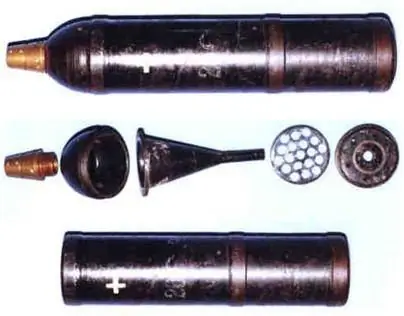
Structurally and externally, the rocket-propelled grenade resembled a 203-mm Japanese rocket projectile. At the head of the rocket-propelled grenade there was a fuse from an 81-mm mine. It was followed by a steel notch and a shaped charge. At the rear was a jet engine with oblique nozzles. Pyroxylin powder was used as a jet fuel. With a length of 359 mm, a rocket-propelled grenade weighed 4.1 kg. Of which 0.7 kg was explosive. Powder charge of a jet engine weighing 0.26 kg accelerated a grenade in a tube up to 160 m / s. The maximum firing range is 750 m, the effective range is 110 m. The weight of the unloaded grenade launcher in the firing position is 8 kg, the length is 1500 mm.

The calculation of the grenade launcher consisted of two people: the gunner and the loader. Shooting, as a rule, was carried out from a prone position. An experienced calculation could produce up to 6 rds / min. When firing behind the grenade launcher, due to the release of the jet stream, a dangerous zone with a length of about 20 m was formed.
Compared to other examples of Japanese anti-tank weapons, the Type 4 grenade launcher was a big step forward. However, the Japanese industry at the final stage of hostilities failed to equip the army with the necessary number of 74-mm rocket-propelled grenade launchers. According to American data, before the end of World War II, about 3,000 anti-tank rocket launchers were fired in Japan. In addition, the rotation of the rocket-propelled grenade reduced the armor penetration due to the "splashing" of the cumulative jet due to the centrifugal force. In the course of hostilities, it turned out that with the declared armor penetration normal to 80-mm, the cumulative grenade cannot guarantee reliable penetration of the frontal armor of the American Shermans and British Matildas.
Due to the insufficient armor penetration of the Type 4 RPG, at the beginning of 1945, a 90-mm RPG was created, which structurally repeated the Type 4, but had an increased caliber. Due to the significant increase in weight, the 90-mm grenade launcher received additional support located at the rear of the barrel.

The mass of the new grenade launcher was about 12 kg, the rocket grenade - 8, 6 kg (of which 1, 6 kg accounted for the explosive and 0, 62 kg for the powder charge of the jet engine). The initial speed of the grenade was 106 m / s, armor penetration - 120 mm, effective firing range - 100 m. Despite successful tests in the army, the mass production of 90-mm grenade launchers was not established.
Japanese tank destroyer tactics
To fight the tanks, the Japanese formed special detachments of 10-12 people. The group was instructed to act smoothly and from an ambush. Two or three people were engaged in setting up a smokescreen, 5-6 people at that time tried to immobilize the tank by blowing up the caterpillar, installed a magnetic mine on board or struck with a pole cumulative mine, blew up the tank with a knapsack land mine. The rest threw Molotov cocktails and grenades, and also covered the actions of the detachment, firing at the enemy infantry, and diverted the attention of the tank crews to themselves. Very often, Japanese troops took refuge in "fox holes", hidden from above with bamboo shields and vegetation. Waiting for a convenient moment, all members of the detachment attacked the approaching tanks.
Protection measures against Japanese infantry tank destroyers
The creation of anti-tank rocket launchers in Japan began too late, and the RPGs that entered the troops did not have a noticeable effect on the course of hostilities. To combat American and British armored vehicles, the Japanese used the "one soldier - one tank" tactic, which implied that, sacrificing himself, one Japanese soldier must destroy one tank. This approach brought the desired effect only at the first stage. Faced with land kamikazes, the Americans, Australians and British began to avoid using tanks in places where it was possible to covertly approach them to install a magnetic mine, strike a pole-shaped cumulative mine, or use a knapsack land mine. In addition to using specially designed anti-tank weapons against enemy tanks, the Japanese infantrymen were instructed to use other techniques: jam the undercarriage with metal rods, break optical devices, jump onto the tank through open hatches, and throw fragmentation grenades inside. It is clear that such methods of dealing with armored vehicles led to colossal losses among those who dared to do so.
In part, the actions of the Japanese infantry were facilitated by poor visibility when fighting in the jungle. Having suffered losses, the Americans began to actively burn vegetation with napalm aircraft tanks, use flamethrower tanks and infantry backpack flamethrowers.
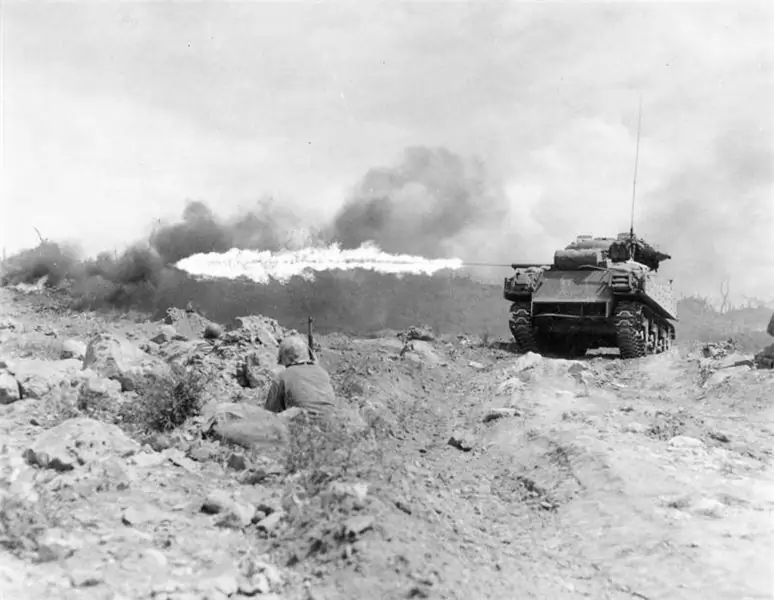
Also, to protect their tanks, the US Army and Marine Corps began to involve infantrymen armed with automatic weapons, and preemptively sweep suspicious places with machine-gun and artillery-mortar fire. Due to the increased consumption of ammunition, it was often possible to disperse and destroy Japanese groups of tank destroyers hidden among tropical vegetation.
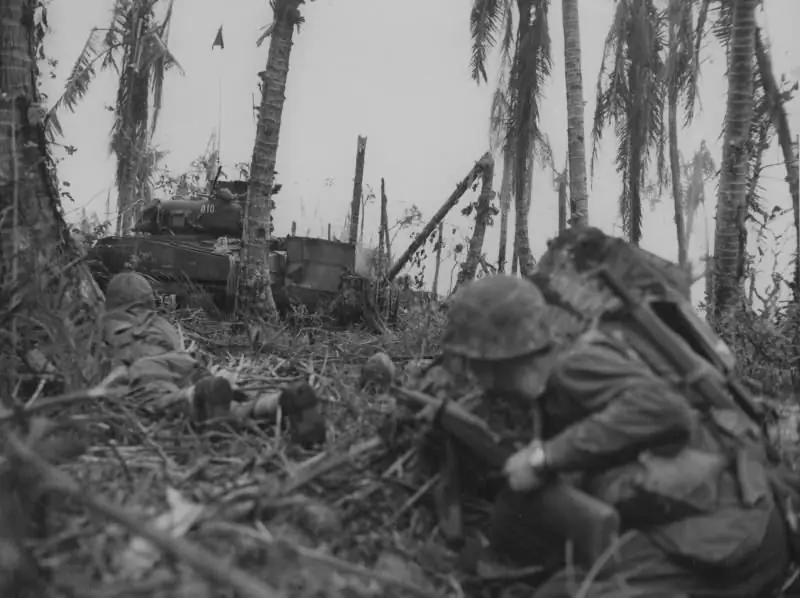
Also, American tankers used passive means of protection: the sides were sheathed with boards, the armor was increased by hanging the tracks, and nails were welded onto the hatches with the tips up or covered with a net, which did not allow the magnetic mine to be installed directly on the hatch. The upper armor was reinforced with sandbags.

Japanese land kamikaze, armed with pole mines and loaded with explosives, tried to delay the advance of Soviet tanks in Manchuria and Korea. However, the vast experience of hostilities by the time the war with Japan began allowed the Red Army to avoid any noticeable losses in armored vehicles. Long before the USSR entered the war against Japan, infantry escorting tanks had become the standard. As a rule, a squad of machine gunners was put on each tank. In this way, even during the battles in Germany, tanks were protected from the "Faustists".






